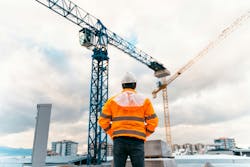Safety Council Report Outlines Lifting Risks
Nearly half of workplace deaths that occur in the crane industry involve workers being struck by objects or equipment, and an additional 27% of fatalities occur as a result of falls and transportation incidents, according to the Census of Fatal Occupational Injuries. According to CFOI, 297 crane-related deaths occurred between 2011 and 2017.
In light of these safety statistics, a report by the National Safety Council identifies top hazardous situations related to crane operations. The report, “Understanding the Current State of Safety Hazards in the Crane Industry,” highlights lift-specific risks and best practices employers can adopt to keep workers safe.
NSC collaborated with the NCCCO Foundation on the report.
Read also: Crosby Updates Crane Camera System
“The crane industry can be dangerous and more must be done to protect workers in this industry,” said Katherine Mendoza, senior director of workplace programs at NSC. “That’s why we have teamed up with the NCCCO Foundation to better understand the main causes of injuries in this field and explore the role that technology can play to eliminate these risks. By understanding these risks and the current state of innovation in the crane industry, we can now explore how to help the industry adopt safety technology and how innovation combined with training and educational resources can make a significant difference in preventing injuries before they occur.”
The groups surveyed certified crane operators and inspectors to identify the most common hazards in the industry, top risk factors, and learn about technology solutions to eliminate or minimize injuries. Nearly 2,200 responded between July and August 2023.
Top hazardous situations in crane operations
- Working at height
- Vehicle-pedestrian interactions
- Loading and unloading materials
Between 55% and 89% of participants said they were likely or very likely to be exposed to these circumstances. In 2020, NSC found these three hazardous situations resulted in 30% of non-roadway occupational fatalities.
The two most common systemic risks contributing to workplace injuries in the crane industry are heat stress and fatigue. The report also found that survey participants reported heat and stress were some of the most likely exposures on the job.
Situational risks remain prevalent in the crane industry, with falls from height and being struck by a falling object being the two most common causes of injuries.
Read also: Turner Construction Signs Deal for AI Crane Safety Tool
Eight out of 10 survey respondents said that they believe they have access to appropriate safety training before starting a task. Even so, lack of proper training still accounted for 7% of personal injuries and 8% of on-site injuries, according to the report.
Technology in crane operations
The use of safety technology—including drones, proximity sensors, and vital sign wearables—is fairly low. Depending on the specific type, only 1% to 13% of participants reported using technology at job sites. Many of those surveyed indicated a willingness to try new safety technology solutions, however, while the primary barrier to adoption was concern over data privacy.
How to reduce crane safety risks
- Heat stress: Working in high-heat environments can lead to both serious injuries and illnesses, including heat stroke, slips, trips, falls, and dropping objects. Employers should develop heat stress prevention programs that include safety training on how to recognize the signs and symptoms. Potential technology solutions that may help mitigate these risks include wearables that monitor people’s vital signs.
- Fatigue: Fatigue can cause workers to have trouble focusing and remembering, which can lead to distractions and less muscle coordination, ultimately resulting in more injuries. Safety training should focus on how to recognize the signs and symptoms, and wearable technology can play an important role in monitoring this issue.
- Struck by falling objects and falls from height: Working-at-height risks can be reduced with fall-protection training and instruction on how to properly use personal fall arrest systems. Potential technology solutions include utilizing drones for inspection and visualization purposes, which eliminate the need for a worker to be off the ground.
About the Author
Rod Sutton
Sutton has served as the editorial lead of Construction Equipment magazine and ConstructionEquipment.com since 2001.
Our mission is to help managers of heavy equipment and trucks to improve their performance in acquiring and managing their fleets. One way we do that is with our Executive Institute, where experts share information and ideas that will enable equipment managers to accurately manage equipment costs so that they can deliver the optimum financial benefits to their organizations.
We also have a laser focus on product development, performance, and technology; as well as equipment acquisition, disposal, and maintenance. Our exclusive Field Tests take earthmoving equipment and truck into the field for professional evaluations.
Check out our free newsletters to see the latest content.
You can find Sutton on LinkedIn.

